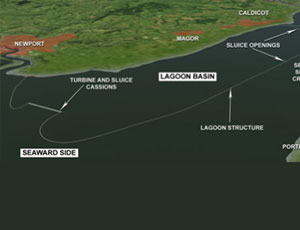Tide Could Supply 5% of U.K. Power, But Barrage Could Damage Environment












Five tidal power schemes, the biggest able to generate 5% of U.K. electricity demand, have been shortlisted for the Severn Estuary, the long sea inlet that separates Wales and Cornwall in the southwest of England. The government's inclusion of a full, $30-billion barrage across the estuary has angered environmental groups.
Having eliminated five schemes, the Dept. of Energy and Climate Change will now consult on its shortlist till April, aiming to select its preferred option early next year. A team led by Parsons Brinckerhoff Ltd., London, is advising DECC.
The most controversial proposal would include a 16-km-long string of turbines in a barrage across the estuary from near Cardiff to Weston. Rated at around 8,600 MW, the scheme would achieve the lowest unit electricity cost, but would be the most intrusive.
Putting the barrage on the shortlist is "hugely disappointing" according to Martin Harper, head of sustainable Development at the Royal Society for the Protection of Birds. A barrage would "destroy huge areas of estuary marsh and mudflats used by 69,000 birds each winter and block the migration routes of countless fish."
Studies nearly 20 years ago by the Severn Tidal Power Group of contractors indicated that 175 vast concrete caissons, up to 45-m tall, would be needed to house turbines and sluice gates.
However, two smaller barrages, the Beachey and the Shoots, are also shortlisted by DECC. Located farther upstream, the barrages, rated at 620 MW and 1,050 MW respectively, would be less disruptive.
Also included are the Bridgewater and Fleming tidal lagoons, both with 1,360 MW installed capacity, and costing up to $7.3 billion. By looping out from one shore, the lagoons would obstruct tidal flows less than barrages.
The Severn's potential for cutting carbon dioxide emissions, by up to 7.2 million tonnes a year, is welcomed by the government's independent Sustainable Development Commission (SDC). But its chairman, Jonathon Porritt, does not want any private-sector-led schemes, "to ensure that the government takes full responsibility for taking a sustainable, long-term approach."
Procurement decisions will be made after the study ends, says a DECC spokeswoman. With a mean tidal range of 8.2 m, the Severn has the world's second highest energy potential, after Canada's Bay of Fundy, according to SDC.









